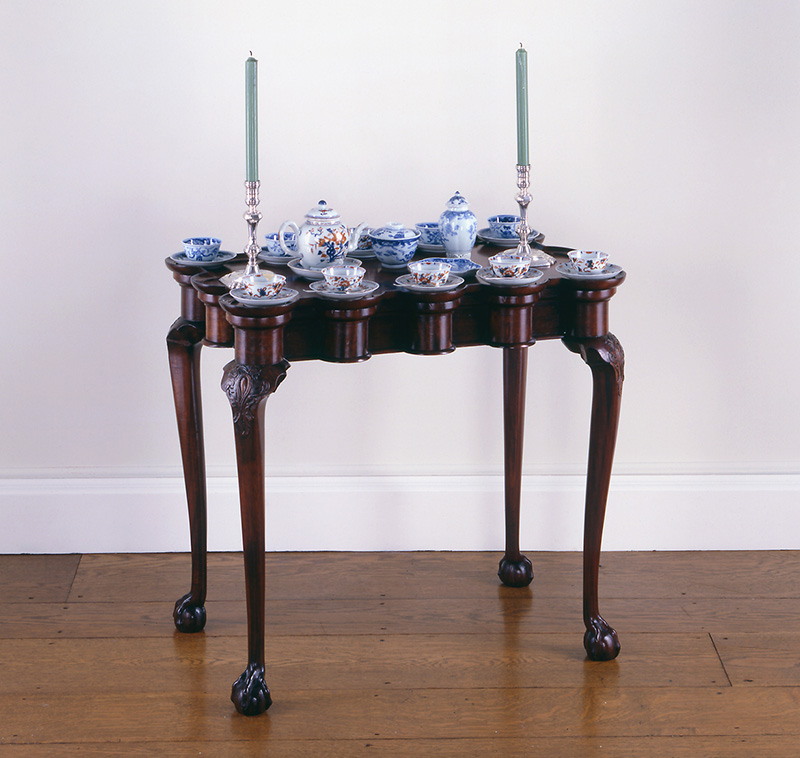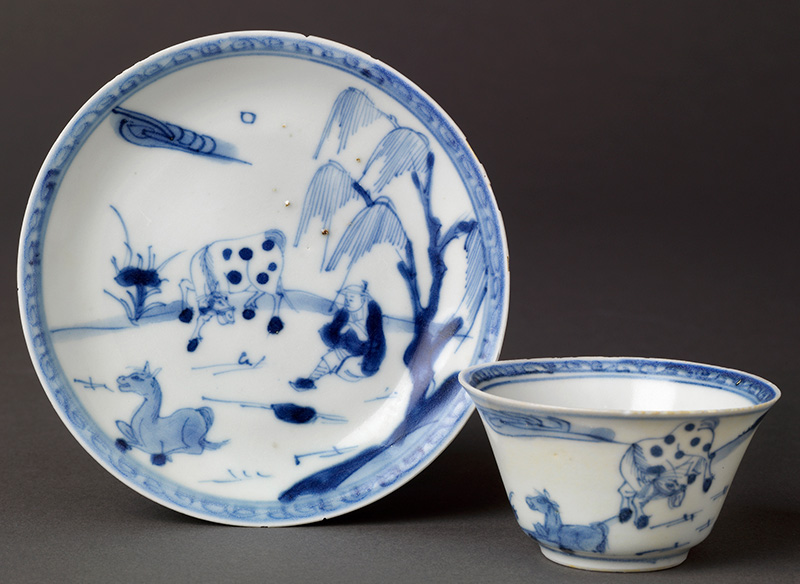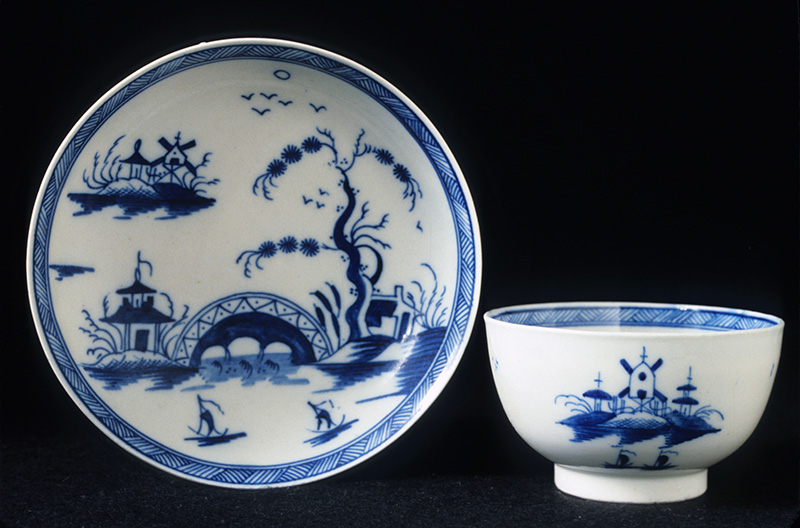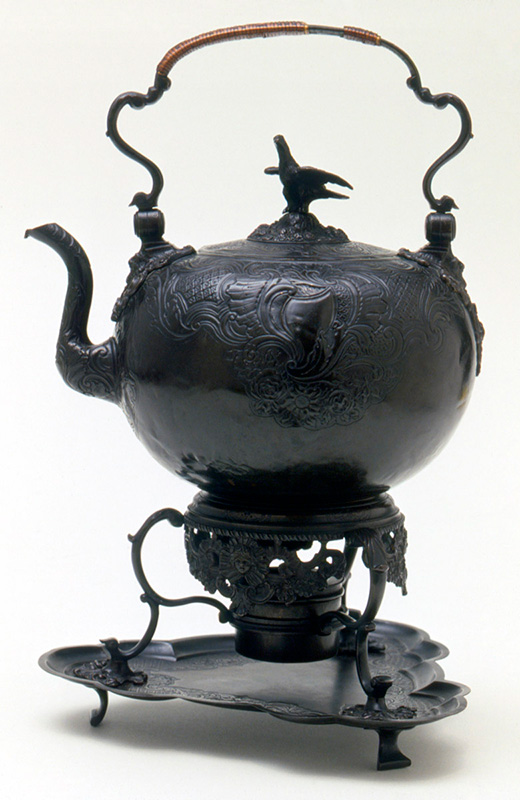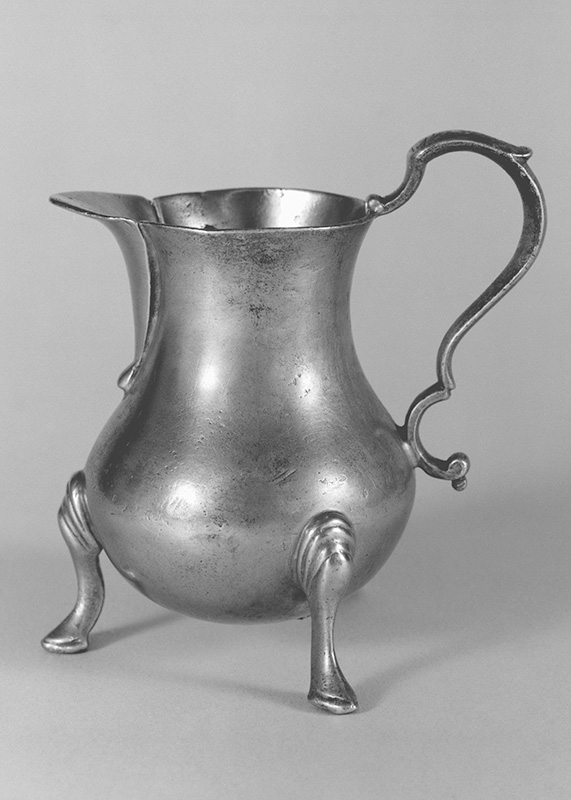Tea Traditions and Tea Ware in Winterthur’s Collection
by Tammy Hong
Tea and the rituals associated with this delicious brew are inseparable from H.F. du Pont’s desire to transform his family home into a space for sharing America’s diverse stories through objects. The materialities of the vessels and tools used to prepare, appreciate, and drink tea in Winterthur’s collection narrate the dialogues associated with the foreign, particularly European, demands for Chinese tea and porcelain that led to innovations in European and American ceramic and metalware manufacture in the 18th and 19th centuries.
Tea table, 1745–65, Boston, MA. Mahogany, pine. Bequest of Henry Francis du Pont, 1958.2774. Teapot, Tea canister (Tea bottle) Sugar bowl, Dish (Stand), Teabowls (Teacups), Saucers, 1740–60, Jingdezhen, China. Porcelain (hard-paste), lime (alkaline) glaze. 1979.0114 A, B; 1959.0077.023 A, B; 1959.0077.022 A, B; 1959.0077.024; 1959.0077.001; 1959.0077.007; 1959.0077.013; 1959.0077.017. John Burt, Candlesticks, 1720–30, Boston, MA. Silver. 1979.0114. Image courtesy Winterthur, photo by Gavin Ashworth.
Tea originated in China and has been an integral part of Chinese culture ever since the Han Dynasty (206 BCE–220 CE). Tea leaves harvested from the Camellia sinensis plant undergo oxidation (or fermentation) before being fried or steamed at high heat to produce distinct colors and flavors. Today, the spirit of tea continues to manifest in Chinese tea ceremonies and rituals. Chinese tea first appeared in the Amsterdam market in 1608. The British East India Company began to import tea into Europe on a commercial scale in 1678. The growing taste for tea in Europe was followed by a great demand for fine porcelain from China.
Kaolin (高岭土 gāo lǐng tǔ) and petunse (白墩子 bái dūn zi), a micaceous rock found in the kaolin deposits in Jingdezhen (景德镇 jǐng dé zhèn) in the Jiangxi (江西) province in China make up the clay body of Chinese porcelain and contribute to the luminosity, transparency, and strength of these wares that were desired by European consumers. Petunse crushed into a fine powder and kaolin mined from the GaoLing Mountains (高嶺山 gāo lǐng shān) were pulverized together in different ratios and mixed with water. The clay was kneaded and manipulated by potters in Jingdezhen by hand. Porcelain vessels were often shaped with a mold, dried, dipped in a colorless glaze made from petunse, limestone, and water before being fired between 1250°C and 1400°C in a kiln built of bricks.[1] Export porcelain was made and decorated in Jingdezhen before being transported to Canton (modern day Guangzhou 广州) in southern China to be exported.
The desire of European monarchs and manufacturers to emulate and imitate Chinese export porcelain in the 18th century is well documented. Some European attempts led to the creation of soft-paste porcelain: porcelain made of clay and ground glass and fired with a lead glaze at approximately 1200°C, a temperature far lower than that of Chinese porcelain.[2] Even though Chinese porcelain and European soft-paste porcelain may be visually similar, soft-paste porcelain wares were much less durable and cracked when exposed to boiling water, making them less practical tea vessels. It was not until 1708 that the Meissen porcelain factory was able to recreate the durable body and luminosity of Chinese objects. These ceramics, termed hard-paste porcelain, were fired at high temperatures between 900–1000°C then fired again with underglaze decoration at 1250–1400°C.
Chinese export porcelain: Tea bowl and saucer, 1723–35, Jingdezhen, China. Porcelain (hard-paste), lime (alkaline) glaze. Winterthur Museum, Garden & Library, 2007.0003.001. Photo by Laszlo Bodo.
The inability of soft-paste porcelain to withstand high temperatures led European and American consumers to rely on teapots and kettles made of silver and copper. These elements could be complemented by other equippage such as cream pitchers and waste bowls. The Winterthur collection includes an English tea kettle made from tin and copper used for boiling hot water, an English pitcher made of pewter for cream and milk, and an American silver slop bowl used to hold tea dregs and waste.
Through examining the tea ware in Winterthur’s collection, one begins to visualize the diverse collage of materials and forms made in China, Europe, and America. This exploration of Mr. du Pont’s vision of American stories through Winterthur’s tea ware demonstrates how objects in the collection are gateways into the transnational narratives, traditions, and hybrid cultural identities that defined and continues to define American cultural identity.
[1] Asian Art Museum, institution. 2019. Traditional Porcelain Production in Jingdezhen, China. Asian Art Museum. Published on YouTube April 23, 2019. Video, 5:18. https://www.youtube.com/watch?v=AU0asyapT_o
[2] Here it is important to note that there is no distinction between soft-paste and hard-paste porcelain in the Chinese context, this is terminology only used in the European material culture framework.
Tammy Hong is the National Endowment for the Humanities Graduate Fellow at the Winterthur/University of Delaware Program in Art Conservation (WUDPAC). She recently presented a series of “Objects Up Close” lectures for Winterthur Museum, Garden & Library, including Tea Traditions and Chinese Export Objects.
About The Decorative Arts Trust Bulletin
Formerly known as the "blog,” the Bulletin features new research and scholarship, travelogues, book reviews, and museum and gallery exhibitions. The Bulletin complements The Magazine of the Decorative Arts Trust, our biannual members publication.
Click Images to Enlarge
Did you know that clicking on the images in Bulletin posts will allow you to get a closer look? Simply click on an image, and a larger version will open in a pop-up window.








